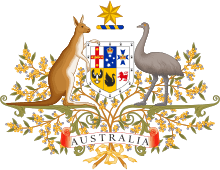South Australian state election, 1982
| | |||||||||||||||||||||||||||||||||||||||||||||||||||||||
| |||||||||||||||||||||||||||||||||||||||||||||||||||||||
| |||||||||||||||||||||||||||||||||||||||||||||||||||||||
| |||||||||||||||||||||||||||||||||||||||||||||||||||||||
State elections were held in Australia on 6 November 1982. All 47 seats in the South Australian House of Assembly were up for election. The incumbent Liberal Party of Australia led by Premier of South Australia David Tonkin was defeated by the Australian Labor Party led by Leader of the Opposition John Bannon.
| Party | Votes | % | Swing | Seats | Change | |
| Australian Labor Party | 353,999 | 46.28 | +5.43 | 24 | +5 | |
| Liberal Party of Australia | 326,372 | 42.67 | -5.27 | 21 | -4 | |
| Australian Democrats | 54,457 | 7.12 | -1.18 | 0 | -1 | |
| Nationals SA | 17,782 | 2.32 | +0.42 | 1 | 0 | |
| Independent | 12,252 | 1.60 | +0.60 | 1 | 0 | |
| Other | 0 | 0.00 | 0 | 0 | ||
| Total | 764,862 | 47 | ||||
| Australian Labor Party | WIN | 50.90 | +5.90 | 25 | +5 | |
| Liberal Party of Australia | 49.10 | -5.90 | 22 | -5 |
Independent: Norm Peterson
Background
Parliamentary elections for both houses of the Parliament of South Australia were held in South Australia in 1982, which saw John Bannon and the Australian Labor Party defeat the incumbent Liberal Party of Australia led by David Tonkin, after one term in power.
As Premier, Tonkin combined fiscal conservatism with socially progressive reforms. In the former, Tonkin made significant cuts to the public service, earning him the enmity of the unions, while an example of the latter was the passage of the land rights bill and the return to the Pitjantjatjara people of 10 per cent of South Australia's area.
Prior to the election, Tonkin removed Robin Millhouse (a former Liberal member who had defected to the Liberal Movement and then the Australian Democrats, and whose popularity enabled him to hold his seat of Waite) with an offer of a vacant seat in the Supreme Court . However the subsequent by-election saw the seat retained by Democrats candidate Heather Southcott, although the Liberals claimed the seat at the 1982 general election.
One potential election factor was the copper and uranium mine at Olympic Dam, near Roxby Downs. Enabling legislation had been passed earlier in 1982, despite the opposition of the Labor Party. In what was a controverisal move in Labor circles, Bannon defused this as an election issue by promising that development would go ahead under a Labor government (a commitment which was honoured), despite having previously opposed it.
The Liberals' chances were not made easier by the poor economic conditions prevalent in Australia in 1982.
After the election loss, Tonkin resigned as Liberal leader and was succeeded by John Olsen, who won a leadership ballot against Dean Brown. A heart complaint caused Tonkin to leave parliament soon after at which a 1983 Bragg by-election was triggered, the Liberals easily retained the seat.
A 1984 Elizabeth by-election saw Independent Labor candidate Martyn Evans win the seat.
Post-election Pendulum
| LABOR SEATS (24) | |||
| Marginal | |||
| Brighton | June Appleby | ALP | 0.8% |
| Newland | John Klunder | ALP | 3.6% |
| Henley Beach | Donald Ferguson | ALP | 4.0% |
| Whyalla | Max Brown | ALP | 4.1% v IND |
| Fairly safe | |||
| Mawson | Susan Lenehan | ALP | 6.6% |
| Unley | Kym Mayes | ALP | 6.6% |
| Norwood | Greg Crafter | ALP | 9.1% |
| Ascot Park | John Trainer | ALP | 9.3% |
| Hartley | Terry Groom | ALP | 10.0% |
| Safe | |||
| Mitchell | Ron Payne | ALP | 10.7% |
| Gilles | Jack Slater | ALP | 10.7% |
| Albert Park | Kevin Hamilton | ALP | 11.1% |
| Florey | Bob Gregory | ALP | 13.2% |
| Playford | Terry McRae | ALP | 14.7% |
| Adelaide | Jack Wright | ALP | 15.6% |
| Price | George Whitten | ALP | 16.1% |
| Baudin | Don Hopgood | ALP | 16.2% |
| Napier | Terry Hemmings | ALP | 19.2% |
| Peake | Keith Plunkett | ALP | 19.5% |
| Elizabeth | Peter Duncan | ALP | 20.0% |
| Stuart | Gavin Keneally | ALP | 20.0% |
| Salisbury | Lynn Arnold | ALP | 22.5% |
| Ross Smith | John Bannon | ALP | 25.7% |
| Spence | Roy Abbott | ALP | 27.9% |
| LIBERAL SEATS (21) | |||
| Marginal | |||
| Coles | Jennifer Adamson | LIB | 1.3% |
| Todd | Scott Ashenden | LIB | 1.4% |
| Morphett | John Oswald | LIB | 1.5% |
| Mount Gambier | Harold Allison | LIB | 2.2% |
| Torrens | Michael Wilson | LIB | 4.5% |
| Fairly safe | |||
| Hanson | Heini Becker | LIB | 8.2% |
| Fisher | Stan Evans | LIB | 9.8% |
| Safe | |||
| Rocky River | John Olsen | LIB | 10.3% |
| Mitcham | Stephen Baker | LIB | 10.4% v AD |
| Murray | David Wotton | LIB | 10.6% |
| Eyre | Graham Gunn | LIB | 12.1% |
| Glenelg | John Mathwin | LIB | 12.4% |
| Light | Bruce Eastick | LIB | 15.2% |
| Chaffey | Peter Arnold | LIB | 15.4% |
| Victoria | Allan Rodda | LIB | 16.6% |
| Kavel | Roger Goldsworthy | LIB | 16.7% |
| Bragg | David Tonkin | LIB | 18.1% |
| Alexandra | Ted Chapman | LIB | 19.0% |
| Goyder | John Meier | LIB | 25.1% |
| Davenport | Dean Brown | LIB | 26.5% |
| Mallee | Peter Lewis | LIB | 30.0% |
| CROSSBENCH SEATS (2) | |||
| Semaphore | Norm Peterson | IND | 10.3% v ALP |
| Flinders | Peter Blacker | NAT | 23.7% v ALP |
Legislative Council Results
| 1982 Legislative Council Result (STV) | |||
| Party | Seats | ||
| Australian Labor Party | 47.0% | 5 | |
| Liberal Party of Australia | 42.1% | 5 | |
| Australian Democrats | 5.5% | 1 | |
| Nationals SA | 2.0% | ||
| 1982-1985 Legislative Council | |||
| Party | Seats | ||
| Liberal Party of Australia | 11 | ||
| Australian Labor Party | 9 | ||
| Australian Democrats | 2 | ||
See also
- Results of the South Australian state election, 1982 (House of Assembly)
- Members of the South Australian House of Assembly, 1982-1985
- Members of the South Australian Legislative Council, 1982-1985
References
- Historical lower house results
- Historical upper house results
- State and federal election results in Australia since 1890
| ||||||||||
| ||||||||||||||||
| ||||||||||||||||||||||||||||



